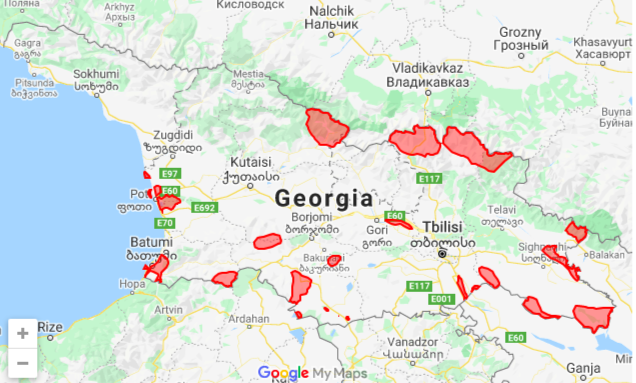Browse by taxonomy
Simple search by name
Vipera kaznakovi
Taxon: Vipera kaznakoviAuthor: Armen Seropian
Uploaded by: Armen_Seropian

Download full size image 2400 X 1513
Name According To: www.faunaeur.org
Species: kaznakovi
Taxon Rank: Species
Scientific Name Authorship: Nikolsky, 1909
Vernacular Name: Caucasian Viper
Georgian Name: კავკასიური გველგესლა
GBD Remarks:
Conservation Status (International): IUCN status (international) EN B2ab(ii,iii,v) ver 3.1. Definition ( Area of occupancy estimated to be less than 500 km2, and the area of occupancy is severely fragmented and continuing decline inferred for the area of occupancy and extent or area or quality of habitats and of mature individuals). Relict narrow-ranged species.
Conservation Status (national): Georgian Red List. IUCN National status (2006) EN B2ab(ii,iii): (Area of occupancy estimated to be less than 500 km2, and the area of occupancy is severely fragmented and continuing decline inferred for the area of occupancy and extent or area or quality of habitats). Georgia covers over 40% of the world-wide range of the species. Included in the list of key animal species, National Biodiversity Strategy and Action Plan for Georgia (2005)
Economic importance (national): Currently absent. Potentially interesting as an attraction of herp-tourists and scientists.
Methodological approaches for potential monitoring: mapping, range modeling, validation of presence at known sites by searching of the animals.
Research institutions: ISU, Institute of Ecology, Institute of Zoology. Currently, no ongoing projects. Monitoring of representative set of selected known populations would include ten field-days for an expert and a trained student biannually.
Relevant website: http://www.iucnredlist.org/details/22990/0 ; http://nacres.org/rept14.html
Why to monitor: Rare endemic viper important for conservation. However, is not considered as a species important for conservation by local population. Economically unimportant.
Preliminary suggestion: Insert existent data (Range model, known locations) in a general easily accessible database for protected species of Georgia. Organise biannual monitorig of presence-absence of vipers at ten locations evenly distributed throughout Georgian range. Requires ca. 10 field days every two years for an expert and a student to conduct.
კონსერვაციული სტატუსი (საერთაშორისო): IUCN სტატუსი EN B2ab(ii,iii,v) ver 3.1. განმარტება ( დაკავებული ფართი, შეფასებით, 500 km2,--ზე ნაკლებია ან დაკავებული ფართი ფრაგმენტირებულია და მცირდება ან უარესდება ჰაბიტატების მდგომარეობა). რელიქტური ვიწროარეალიანი სახეობა.
კონსერვაციული სტატუსი (ეროვნული): საქართველოს წითელი ნუსხა. IUCN ეროვნული სტატუსი (2006) EN B2ab(ii,iii): ( დაკავებული ფართი, შეფასებით, 500 km2,--ზე ნაკლებია ან დაკავებული ფართი ფრაგმენტირებულია და მცირდება ან უარესდება ჰაბიტატების მდგომარეობა). საქართველოში მდებარეობს ამ სახეობის არეალის 40% -ზე მეტი. შეტანილია საკვანძო სახეობების ნუსხაში, საქართველოს ბიომრავალფეროვნების სტრატეგია და მოქმედებათა გეგმა (2005)
ეკონომიკური მნიშვნელობა (ეროვნული): ამჟამად არ არსებობს. პოტენციალურად საინტერესო სახეობაა ბუნების მოყვარული ტურისტებისთვის და მეცნიერებისთვის.
მონიტორინგის მეთოდოლოგია: დარუკება, არეალის მოდელირება, ცნობილი ლოკალიტეტების ვალიდაცია.
კონტაქტები/ მიმდინარე პროექტები: ილიას სახელმწიფო უნივერსიტეტი, ეკოლოგიის ინსტიტუტი, ზოოლოგიის ინსტიტუტი. მიმდინარე პროექტები არ არსებობს. ცნობილი ჰაბიტატების მონიტორინგი შესაძლებელია.
რელევანტური ლინქები: http://www.iucnredlist.org/details/22990/0; http://assets.panda.org/downloads/cepf_caucasus_web_1.pdf
რატომაა მიზანშეწონილი მონიტორინგი: იშვიათი ენდემური გველგესლა.
რეკომენდაცია: არსებული ინფორმაცია ჰაბიტატების შესახებ შეტანილ იქნას მისაწვდომ მონაცემთა ბაზაში, გაკეთდეს 10 ჰაბიტატის მონიტორინგი ორ წელიწადში ერთხელ.
Page Authors: David Tarkhnishvili ,
Reference of occurrence in Georgia: Tarkhnishvili, D., A. Kandaurov & A. Bukhnikashvili, 2002. Declines of amphibians and reptiles in Georgia during the 20th century: virtual vs. actual problems. Zeitschrift fur Feldherpetologie 9: 89-107.
Conservation Status
This section is under construction
National Red List Status of have not been evaluated

